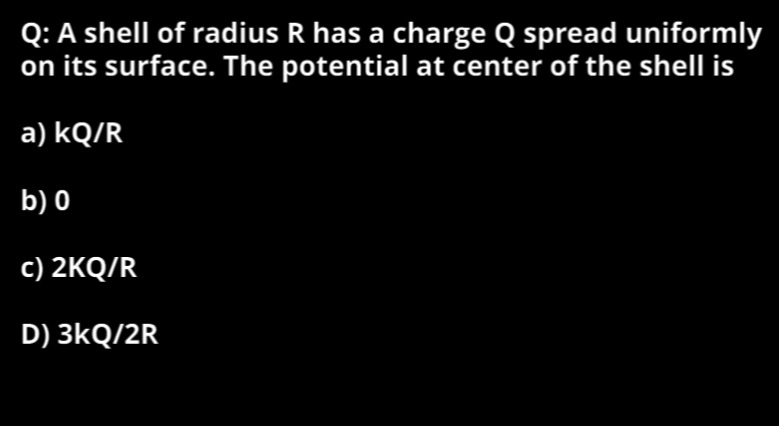Question
Question: A shell of radius R has a charge Q spread uniformly on its surface. The potential at center of the s...
A shell of radius R has a charge Q spread uniformly on its surface. The potential at center of the shell is

kQ/R
0
2KQ/R
3kQ/2R
kQ/R
Solution
The potential at a point due to a continuous charge distribution is given by the integral of the potential contribution from each infinitesimal charge element.
Consider an infinitesimal charge element dq on the surface of the spherical shell. The charge is spread uniformly on the surface of radius R and total charge Q. The surface charge density is σ=4πR2Q.
An infinitesimal area element dA on the surface has a charge dq=σdA=4πR2QdA.
The distance of this charge element dq from the center of the shell is R.
The potential dV at the center due to this charge element dq is given by:
dV=Rk⋅dq
where k is Coulomb's constant.
To find the total potential V at the center, we integrate dV over the entire surface of the shell:
V=∫dV=∫surfaceRk⋅dq
Since k and R are constants with respect to the integration over the surface, we can take them out of the integral:
V=Rk∫surfacedq
The integral of dq over the entire surface is the total charge Q on the shell:
∫surfacedq=Q
Therefore, the potential at the center of the shell is:
V=Rk⋅Q=RkQ
Alternatively, we know that the electric field inside a uniformly charged spherical shell is zero everywhere (E=0 for r<R). The relationship between electric potential and electric field is E=−∇V. In the radial direction, Er=−drdV. Since Er=0 for r<R, it means drdV=0, which implies that the potential V is constant everywhere inside the shell.
The potential inside the shell is equal to the potential on the surface of the shell. The potential at any point on the surface (at distance R from the center) due to the uniformly distributed charge Q is RkQ. Since the potential is constant inside the shell and equal to the potential on the surface, the potential at the center (which is inside the shell) is also RkQ.
